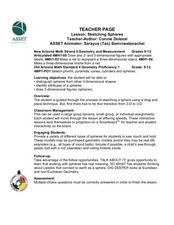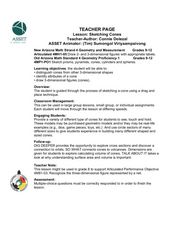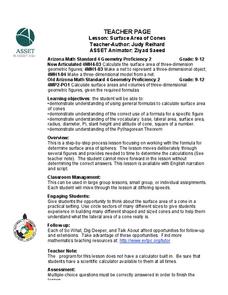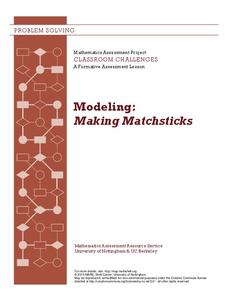Curated OER
Volume of a Snow Cone
Learners find the volume of a snow cone. They divide the snow cone into known sections, and find the are of each part. Pupils must read the scale on the snow cone, prior to plugging into the formula for its volume.
Curated OER
Flower Vases
Which vase holds more water: a cylinder, sphere, or cone? Figure out which should be used for your sister's birthday bouquet with this practical word problem.
EngageNY
The Volume Formula of a Sphere
What is the relationship between a hemisphere, a cone, and a cylinder? Using Cavalieri's Principle, the class determines that the sum of the volume of a hemisphere and a cone with the same radius and height equals the volume of a...
EngageNY
Cones and Spheres
Explore methods for finding the volume of different three-dimensional figures. The 20th instructional activity in the 25-part series asks learners to interpret diagrams of 3-D figures and use formulas to determine volume. Scholars must...
Curated OER
Cones, Cylinders, Spheres
Students classify polygons by name and shape. In this geometry activity, students identify the lateral surface of each conic. They differentiate between cones, cylinders and spheres.
Curated OER
Volume of Solid Figures
Learners calculate volume using the correct formula and the correct unit. They explore different prisms, spheres, cubes, and cones as they calculate volume and relate it to depths in oceans.
Curated OER
We All Scream for Ice Scream
High schoolers explore the formulas for volume of three-dimensional objects. They participate in various activities involving ice cream, ice cream cones, small candies, and gum balls, recording their calculations on a lab sheet.
Curated OER
A Sphere and Its Net
Students identify and sketch the nets for sphere. In this geometry instructional activity, students differentiate between two and three dimensional shapes. They find the surface area of each sphere.
Curated OER
Identify Cones
Third graders evaluate the attributes of cones. In this space shapes lesson, 3rd graders analyze three-dimensional shapes. Students explore the faces and edges of a cone.
Curated OER
Sphere Dressing
Geometric design makes a fashion statement! Challenge learners to design a hat to fit a Styrofoam model. Specifications are clear and pupils use concepts related to three-dimensional objects including volume of irregular shapes and...
Curated OER
Sketching Spheres
Pupils investigate spheres through sketches. In this geometry lesson, students sketch two and three dimensional shapes creating nets. They find and differentiate between the nets for prisms, pyramids, cones, cylinders and spheres.
Curated OER
Sketching Cones
Students sketch cones and identify its properties. In this geometry lesson, students calculate the surface area and volume of each three dimensional shape. they define and sketch prisms, pyramids and cylinders.
Curated OER
Surface Area of Cones
Students find the surface area of cones. In this geometry lesson, students calculate the dimensions of each three-dimensional shape and use the correct formula to solve the problem. They relate concepts of cones to the real world.
Curated OER
Shapely Figures
Students are given magazines, scissors, glue, and one sheet of construction paper. They look for pictures showing real life representations of rectangular prisms, spheres, cones, and pyramids. Pupils cut out pictures showing each of...
Curated OER
Living in a Geometrical World
Learners participate in a series of hand-on, online, and multimedia activities to examine 2 dimensional and 3 dimensional shapes. They describe common geometric solids. They construct rectangular prisms using straws and ribbon.
Learner
Solid Shapes
A collection of two lessons, kindergartners will identify two-dimensional shapes in solid shapes. They will develop basic knowledge of the components that make up a sphere, rectangular prism, pyramid, cylinder, cone, and cube. Young...
EngageNY
Volume and Cavalieri’s Principle
Take a slice out of life. The ninth section in a series of 23 introduces classmates to Cavalieri's principle using cross sections of a cone and stacks of coins. Class members participate in a discussion using pyramids and how Cavalieri's...
Willow Tree
Surface Area of Three-Dimensional Figures
Lateral area and surface area are simple concepts, but calculating them is not as easy! Using formulas, learners calculate lateral area and surface area for the same three-dimensional figures. The resource discusses the formula variables...
Mathematics Assessment Project
Modeling: Making Matchsticks
Math: The only subject where the solution to a problem is seven million matches. Young scholars first complete an assessment task estimating the number of matches they can make from a tree of given dimensions. They then evaluate provided...
Curated OER
Learning About Volume
Learners explore the concept of volume. They develop formulas for volume of prisms. Then use their formulas to find missing dimensions of various prisms such as height, length, width, radius, and diameter.
Curated OER
Why are Bubbles Spheres
Learners calculate the surface area of different polygons. In this geometry lesson, students practice calculating the volume of spheres. They work with cones, cylinders and rectangular prisms.
Curated OER
Volume Worksheet I
In this volume worksheet, students recognize three-dimensional figures, identify the proper volume formula, and then solve the equation by inserting information from a diagram into the formula. Students solve six equations.
Curated OER
Introduction to Minerals
Learners discover how crystal structures go together to create minerals. In this earth science lesson, students work in groups to create 3-dimensional shapes of crystals that they then put together in a compact structure.
Curated OER
Nets, Surface Area and Volume
Students calculate the surface area and volume of a sphere. In this geometry lesson, students define nets, surface areas and volume of prisms, pyramids, cylinders and cones. They use the computer to create nets and analyze shapes.

























